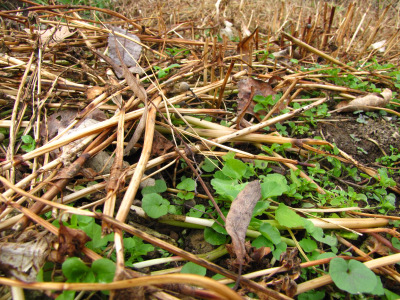
Buckwheat and oat cover crops as a mulch
 I'm
sure you're all dying to read another installment in my obsession with
cover crops, so here goes! You may remember that we last left our
heroes in a state of disarray, with the buckwheat and then the oats
cut to the ground to prevent seed-setting. So what does the
garden look like now?
I'm
sure you're all dying to read another installment in my obsession with
cover crops, so here goes! You may remember that we last left our
heroes in a state of disarray, with the buckwheat and then the oats
cut to the ground to prevent seed-setting. So what does the
garden look like now?
Buckwheat continues to
fall behind my expectations. The succulent stems melted into the
soil so quickly that weeds grew up through them just a few weeks
later. (Bonus points to readers of my winter weeds post who can identify the problem
plants in the photo above.) I had to come back by and toss a
heavy coat of straw mulch on top of the greenery to keep the weeds at
bay. My conclusion is that buckwheat has just a few advantages
and many disadvantages. On the pro side, the cover crop grows
very quickly, feeds the bees, and will cope with the summer heat (which
most other cover crops hate). But buckwheat can't handle
waterlogged clay soil and leaves very little organic matter behind,
defeating the purpose of a cover crop as a soil builder in our
garden. In the future, I'll only use buckwheat to fill quick gaps
in the summer garden that would otherwise be bare.

Oats is the exact
opposite, exceeding my expectations at every turn. The early
oats, which I mowed down with hedge trimmers, covered the ground so
well that no weeds are poking through (though I did throw a few
handfuls of straw around the edges of the beds just in case.) A
quick and dirty job of mowing killed about 90% of the plants, and I
suspect that the few green stems still standing will die back over the
winter. In addition to all of the organic matter which their
roots are depositing below ground, the oats produced such a mass of
leaf growth that the beds I cut now look nearly identical to nearby
beds that I mulched with straw. I wish I'd planted every square
inch I could get my hands on with oats!
Want more in-depth information? Browse through our books.
Or explore more posts by date or by subject.
About us: Anna Hess and Mark Hamilton spent over a decade living self-sufficiently in the mountains of Virginia before moving north to start over from scratch in the foothills of Ohio. They've experimented with permaculture, no-till gardening, trailersteading, home-based microbusinesses and much more, writing about their adventures in both blogs and books.
Want to be notified when new comments are posted on this page? Click on the RSS button after you add a comment to subscribe to the comment feed, or simply check the box beside "email replies to me" while writing your comment.
